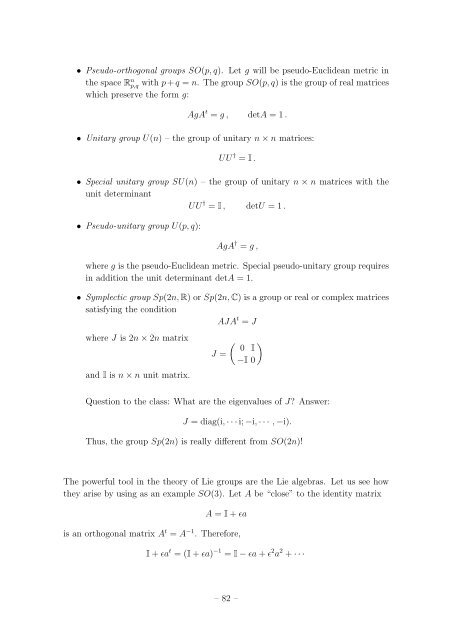Student Seminar: Classical and Quantum Integrable Systems
Student Seminar: Classical and Quantum Integrable Systems
Student Seminar: Classical and Quantum Integrable Systems
Create successful ePaper yourself
Turn your PDF publications into a flip-book with our unique Google optimized e-Paper software.
• Pseudo-orthogonal groups SO(p, q). Let g will be pseudo-Euclidean metric in<br />
the space R n p,q with p + q = n. The group SO(p, q) is the group of real matrices<br />
which preserve the form g:<br />
AgA t = g , detA = 1 .<br />
• Unitary group U(n) – the group of unitary n × n matrices:<br />
UU † = I .<br />
• Special unitary group SU(n) – the group of unitary n × n matrices with the<br />
unit determinant<br />
UU † = I , detU = 1 .<br />
• Pseudo-unitary group U(p, q):<br />
AgA † = g ,<br />
where g is the pseudo-Euclidean metric. Special pseudo-unitary group requires<br />
in addition the unit determinant detA = 1.<br />
• Symplectic group Sp(2n, R) or Sp(2n, C) is a group or real or complex matrices<br />
satisfying the condition<br />
AJA t = J<br />
where J is 2n × 2n matrix<br />
<strong>and</strong> I is n × n unit matrix.<br />
J =<br />
( ) 0 I<br />
−I 0<br />
Question to the class: What are the eigenvalues of J? Answer:<br />
J = diag(i, · · · i; −i, · · · , −i).<br />
Thus, the group Sp(2n) is really different from SO(2n)!<br />
The powerful tool in the theory of Lie groups are the Lie algebras. Let us see how<br />
they arise by using as an example SO(3). Let A be “close” to the identity matrix<br />
A = I + ɛa<br />
is an orthogonal matrix A t = A −1 . Therefore,<br />
I + ɛa t = (I + ɛa) −1 = I − ɛa + ɛ 2 a 2 + · · ·<br />
– 82 –

















